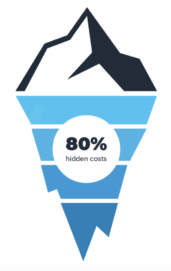The Hidden Costs of Distribution Point Management
Microsoft Endpoint Manager (MEM) – in particular Microsoft Systems Center Configuration Manager (SCCM) – is the gold standard of software distribution platforms, but that doesn’t mean it’s perfect. There are two main issues at play:
- From Gartner’s Magic Quadrant for Unified Endpoint Management : “Clients’ most common concern is that using MEM is not easy. Reasons include the overhead required to architect, build and maintain Configuration Manager and integration between on-premises Active Directory (AD) and Azure AD. Managing some policies (like Windows Hello) requires use of multiple consoles.”
- Another big challenge associated with delivering software via ConfigMgr is that, with the rise of Windows as a Service (WaaS) for Windows 10 updates, application and image deployments have become so frequent and bandwidth heavy that they can easily disrupt your network.
While Windows does offer several free cache solutions to help fix the bandwidth issue, none standalone in their ability to efficiently deliver software at scale, nor are they easy to use. (Think: continuous management of network boundaries.) For years, the only option IT and network teams had to address this issue effectively was to purchase hardware distribution points and deploy them in strategic office locations. Unfortunately, this often introduced as many problems as it intended to fix – increasing the infrastructure footprint, for example – and became even more expensive as a result.
What’s Under the Iceberg?
 A lot of organizations look at distribution points as a one-time purchase without considering the ongoing operational costs associated with software delivery. Like an iceberg however, the total cost of ownership (TCO) for hardware distribution points extends far beyond the surface.
A lot of organizations look at distribution points as a one-time purchase without considering the ongoing operational costs associated with software delivery. Like an iceberg however, the total cost of ownership (TCO) for hardware distribution points extends far beyond the surface.
Here’s a look at some of the hidden costs:
- Storage
- Rack space
- Power and cooling
- O/S license
- Server maintenance
- Network connectivity
- Support – headquarters and regional
- Off-hours monitoring
- Packaging and throttling
- Time-consuming deployment processes
Altogether, the hidden costs of distribution points account for up to 80% of TCO.
What About Virtual Distribution Points?
Many of you may have already transitioned to a more digitized approach to software delivery and are using virtual distribution points with a cloud management gateway (CMG) in lieu of hardware. While this does help to eliminate hard costs like storage, rack space, power and cooling, there is a risk of excess data egress costs from your cloud provider.
Public clouds charge based on outbound data transfer. For smaller organizations, the cost is minimal. But enterprises that use terabytes of data to send regular software updates to thousands of employees pay substantially more.
Use a Hybrid Approach to Accelerate SCCM Deliveries Instead
One way to reduce distribution points – and the costs associated with them – is to invest in a software-defined solution like Kollective for Software Delivery instead.
Kollective’s enterprise content delivery network (ECDN) leverages Microsoft Azure to provide a secure cloud-native architecture and unique peering technology to deliver software more efficiently and at scale through an integration with your SCCM. The unique solution allows you to offload delivery from the wide area network (WAN), saving 95% of the bandwidth typically consumed by software delivery.
It can even help with remote workers. VPN saturation is a common occurrence for organizations with a large number of employees working from home. Deploying frequent bandwidth-heavy software updates can result in dropped connections, poor user experience and slowed internet – they also put business critical applications at risk.
See How Much You Can Save by Minimizing Distribution Points
Kollective for Software Delivery needs only one distribution point to scale software deployments. If you currently have 50 hardware-based distribution points and 10,000 employees, Kollective can save you nearly $2 million over a five year period.
Want to see how much you can save? Use our TCO calculator to find out.
The post The Hidden Costs of Distribution Point Management appeared first on Kollective Technology .

 The technology industry is notable for a variety of reasons. It represents 7 out of the top 10 publicly traded firms ranked by market capitalization. In the past half-century, it is responsible for more of the advancements that have changed the way we live and work than any other industry. And finally, although this may be subjective, there is no other industry that uses more acronyms than ours. I could fill an entire book dedicated to decoding and explaining the myriad acronyms used in technology. However, since I don’t have time to do that, I’ll focus on two that represent some of the hottest technologies in storage today – NVMe and RDMA.
The technology industry is notable for a variety of reasons. It represents 7 out of the top 10 publicly traded firms ranked by market capitalization. In the past half-century, it is responsible for more of the advancements that have changed the way we live and work than any other industry. And finally, although this may be subjective, there is no other industry that uses more acronyms than ours. I could fill an entire book dedicated to decoding and explaining the myriad acronyms used in technology. However, since I don’t have time to do that, I’ll focus on two that represent some of the hottest technologies in storage today – NVMe and RDMA.